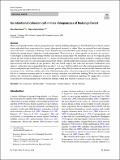Files in this item
An intentional cohesion call in male chimpanzees of Budongo Forest
Item metadata
| dc.contributor.author | Bouchard, Alice | |
| dc.contributor.author | Zuberbühler, Klaus | |
| dc.date.accessioned | 2022-02-07T12:30:03Z | |
| dc.date.available | 2022-02-07T12:30:03Z | |
| dc.date.issued | 2022-01-19 | |
| dc.identifier.citation | Bouchard , A & Zuberbühler , K 2022 , ' An intentional cohesion call in male chimpanzees of Budongo Forest ' , Animal Cognition , vol. First Online . https://doi.org/10.1007/s10071-022-01597-6 | en |
| dc.identifier.issn | 1435-9448 | |
| dc.identifier.other | PURE: 277723483 | |
| dc.identifier.other | PURE UUID: e8ca0ba3-2f18-4798-bd26-199aa3be6093 | |
| dc.identifier.other | Jisc: 5c53407116b74ab8b8b889b7c3a11538 | |
| dc.identifier.other | PubMed: 35044524 | |
| dc.identifier.other | pii: 10.1007/s10071-022-01597-6 | |
| dc.identifier.other | Scopus: 85123087421 | |
| dc.identifier.other | ORCID: /0000-0001-8378-088X/work/107717983 | |
| dc.identifier.other | WOS: 000744372100001 | |
| dc.identifier.uri | https://hdl.handle.net/10023/24815 | |
| dc.description | Open access funding provided by University of Neuchâtel. This research was supported by the University of Neuchatel and the Swiss National Science Foundation (Project Grant #310030_185324 and NCCR Evolving Language, Agreement #51NF40_180888). | en |
| dc.description.abstract | Many social animals travel in cohesive groups but some species, including chimpanzees, form flexible fission-fusion systems where individuals have some control over group cohesion and proximity to others. Here, we explored how male chimpanzees of the Sonso community of Budongo Forest, Uganda, use communication signals during resting, a context where the likelihood of group fission is high due to forthcoming travel. We focused on a context-specific vocalisation, the 'rest hoo', to investigate its function and determine whether it is produced intentionally. We found that this call was typically given towards the end of typical silent resting bouts, i.e., the period when individuals need to decide whether to continue travelling after a brief stop-over or to start a prolonged resting bout. Subjects rested longer after producing 'rest hoos' and their resting time increased with the number of calls produced. They also rested longer if their calls were answered. Furthermore, focal subjects' resting time was prolonged after hearing others' 'rest hoos'. Subjects called more when with top proximity partners and in small parties and rested longer if a top proximity partner called. We also found an interaction effect between rank and grooming activity, with high-ranking males with a high grooming index calling less frequently than other males, suggesting that vocal communication may serve as a cohesion strategy alternative to tactile-based bonding. We discuss these different patterns and conclude that chimpanzee 'rest hoos' meet key criteria for intentional signalling. We suggest that 'rest hoos' are produced to prolong resting bouts with desired partners, which may function to increase social cohesion. | |
| dc.format.extent | 14 | |
| dc.language.iso | eng | |
| dc.relation.ispartof | Animal Cognition | en |
| dc.rights | Copyright © The Author(s) 2022. Open Access. This article is licensed under a Creative Commons Attribution 4.0 International License, which permits use, sharing, adaptation, distribution and reproduction in any medium or format, as long as you give appropriate credit to the original author(s) and the source, provide a link to the Creative Commons licence, and indicate if changes were made. The images or other third party material in this article are included in the article's Creative Commons licence, unless indicated otherwise in a credit line to the material. If material is not included in the article's Creative Commons licence and your intended use is not permitted by statutory regulation or exceeds the permitted use, you will need to obtain permission directly from the copyright holder. | en |
| dc.subject | Pan troglodytes | en |
| dc.subject | Vocalisation | en |
| dc.subject | Group cohesion | en |
| dc.subject | Social cognition | en |
| dc.subject | Intentionality | en |
| dc.subject | QL Zoology | en |
| dc.subject | BF Psychology | en |
| dc.subject | DAS | en |
| dc.subject.lcc | QL | en |
| dc.subject.lcc | BF | en |
| dc.title | An intentional cohesion call in male chimpanzees of Budongo Forest | en |
| dc.type | Journal article | en |
| dc.description.version | Publisher PDF | en |
| dc.contributor.institution | University of St Andrews. Organic Semiconductor Centre | en |
| dc.contributor.institution | University of St Andrews. School of Psychology and Neuroscience | en |
| dc.contributor.institution | University of St Andrews. Institute of Behavioural and Neural Sciences | en |
| dc.contributor.institution | University of St Andrews. Centre for Social Learning & Cognitive Evolution | en |
| dc.identifier.doi | https://doi.org/10.1007/s10071-022-01597-6 | |
| dc.description.status | Peer reviewed | en |
This item appears in the following Collection(s)
Items in the St Andrews Research Repository are protected by copyright, with all rights reserved, unless otherwise indicated.

